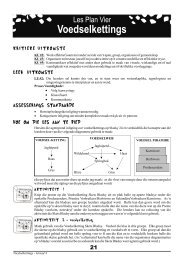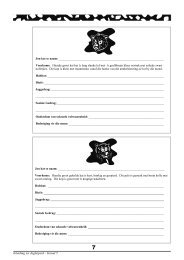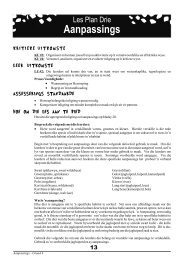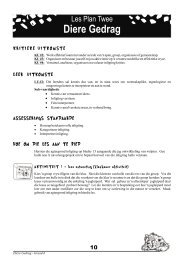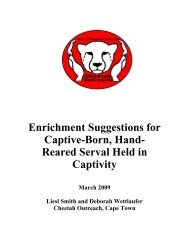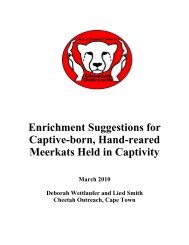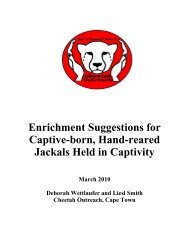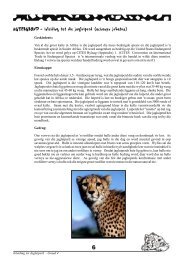Enrichment Suggestions for Captive-born, Hand-reared Caracal ...
Enrichment Suggestions for Captive-born, Hand-reared Caracal ...
Enrichment Suggestions for Captive-born, Hand-reared Caracal ...
You also want an ePaper? Increase the reach of your titles
YUMPU automatically turns print PDFs into web optimized ePapers that Google loves.
<strong>Enrichment</strong><br />
Animals in captivity have a lot of time on their hands. Whereas wild animals would fill<br />
their time with activities such as hunting, searching <strong>for</strong> water or shelter, protecting their<br />
territory or searching <strong>for</strong> a mate, captive animals very often are provided all of these.<br />
This could potentially create problems such as boredom, frustration, stereotypic behaviors<br />
and stress. Undesirable behaviours include self-injurious actions like excessive grooming;<br />
abnormal behaviours such as regurgitation and reingestion; aggressive behaviours; and<br />
stereotypic behaviours. Behaviour is an important indication of welfare and enrichment<br />
enhances welfare of animals in captivity.<br />
<strong>Enrichment</strong> becomes a valuable and necessary practice by creating activities or providing<br />
stimulation that maximizes their quality of life and leads to inquisitive behavior.<br />
By enriching the animal’s environment, you empower the animal to have control over its<br />
environment and you give the animal a choice. Ignoring something is still a choice.<br />
Apart from the fact that enrichment provides methods of passing time, the added physical<br />
and mental stimulation might also cause better reproductive success and improve visitor’s<br />
experiences since the image of healthy and well-adjusted animals are promoted.<br />
Different <strong>for</strong>ms of enrichment used <strong>for</strong> captive animals today include:<br />
Enclosure Design<br />
Feeding or <strong>for</strong>aging<br />
Visual and Auditory<br />
Olfactory<br />
Novel Objects and Toys<br />
Exercise<br />
Social Interaction/Tactile<br />
Behavioural Conditioning<br />
<strong>Enrichment</strong> should be considered part of the daily husbandry routine at all responsible<br />
animal care facilities. An efficient enrichment programme can be more important than the<br />
size of the enclosures the animals are kept in. Environmental enrichment is not a luxury but<br />
a management tool.<br />
When developing an enrichment programme at a captive facility, the habits, behaviours and<br />
nature of the species, and the personality of the specific individual need to be considered.<br />
<strong>Enrichment</strong> suggestions <strong>for</strong> the caracal include the following:<br />
Produced by Cheetah Outreach (Last Updated: November 2012)<br />
Copyright © 2010-2013 Cheetah Outreach. All rights reserved.<br />
cheetah@intekom.co.za Http://www.cheetah.co.za<br />
Homes Provided by Heartland and Eikendal<br />
2



